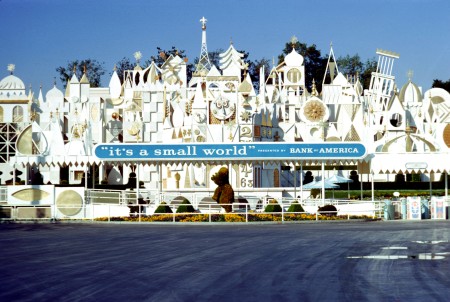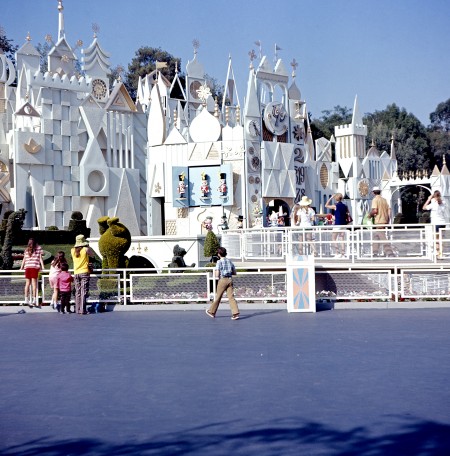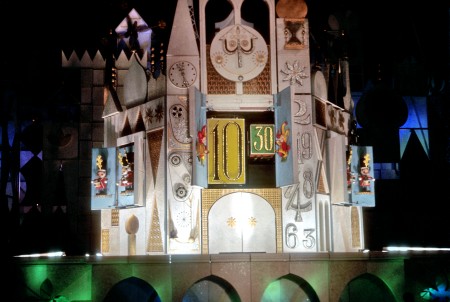Pepsi Pavilion Marquee for "It's
a Small World"
 |
As the 1965 Fair season
began to wind down, the Walt Disney Company had to deal with
long-term planning for how their four New York World's Fair shows
would fit into Disneyland as permanent attractions. The planning
for "It's A Small Worlds'" future at the Anaheim park
proved the least problematic for Disney since there was no haggling
for sponship of the attraction as with General Electric, Ford
or the State of Illinois (Bank of America would replace Pepsi
as official sponsor of the "Small World" ride in Anaheim
since Pepsi already sponsored an existing Disneyland attraction,
the Golden Horseshoe Revue). The ride would be brought
back to California and would become a new centerpiece for Fantasyland
which had not expanded much beyond its original group of "dark
rides" that opened with the park in 1955.
However, the elaborate
"Tower of the Four Winds" would not be making the trip
west. Fantasyland lacked the space to accommodate such a large
sculpture and not even its designer, Rolly Crump, had been particularly
enamored with it. It had always been seen by Crump and Walt Disney
as more of a counteracting force for the less-than-stellar design
of the New York show building which Crump considered nothing
more than a big, ugly "corrugated barn." With Mary
Blair (illustrator for most of the "Small World" figures)
commissioned to design an elaborate new facade for the Fantasyland
building, the Tower wouldn't be needed to call attention away
from the building itself as was the case in New York. Nonetheless,
before the final decision was made, Disney made sure that Crump
felt leaving the Tower behind was the right decision, going so
far as to feign interest in bringing it back to make sure that
all of his people, especially Crump, felt strongly about
the matter. When the Disney people packed up the sets, dolls,
boats and water trough in New York for transport back to Anaheim,
the Tower was simply left behind (where rumor has it that it
was cut up and dumped into the Flushing river; to this day, there
are Fair enthusiasts who dream of dredging the river to find
recognizable fragments of this World's Fair landmark).
Mary Blair's elaborate facade
for the Fantsyland home of "it's a small world."
 |
Disney's "Imagineers"
made some adjustments to "Small World" that improved
the ride in Anaheim. With more space available for the show building
(to make room, the Fantasyland Railroad Station and the "Midget
Autopia" car ride, for children too small to ride its celebrated
Tomorrowland counterpart, fell victim to the wrecker's ball),
two sections were added to the ride representing the Islands
of the Pacific and the North Pole, while several others were
slightly lengthened. A giant thirty-foot-high clock, designed
by Crump for the front of the facade, proved to be the most elaborate
new touch. Every fifteen minutes guests waiting in line outside
to board their boats would hear a loud chime from the clock followed
by two dozen animated "children of the world" toys
emerging from doors underneath the clock to parade about. In
effect, this took the place of the Tower of the Four Winds as
an eye-catching feature for waiting tourists to focus upon.
The Disneyland version
of "it's a small world" (Disney's official presentation
of the name of the attraction is in all lower-case letters)
opened on May 28, 1966 in what turned out to be the last new
Disneyland attraction Walt Disney would live to see opened (Disney
passed away on December 15, 1966 at the age of 65). In typical
Disney style, 1,500 visiting dignitaries were invited to an elaborate
opening ceremony that saw 10,000 balloons released. Water was
imported from sources from around the world in order for "small
world" to symbolically live up to its image of providing
a journey through the "Seven Seaways of the World."
The popularity of "small
world" guaranteed its presence in all future Disney Parks
and one can find near-identical versions in Florida, Tokyo, Paris
and Hong Kong. The Anaheim version has the distinction of being
the original version displayed in New York (indeed, as E-Ticket
magazine noted, some set pieces in Anaheim still have their transport
tags from New York to Anaheim on them to this day!) It thus represents
something special to World's Fair enthusiasts: so long as there
are Disney theme parks, "it's a small world" will forever
stand as the last surviving attraction from an Industrial Pavilion
at the New York World's Fair to endure in its original state.
The reasons for how "small
world" has been able to achieve this status are worth noting.
Of the four Disney-based attractions at the Fair, "it's
a small world" is the most simple in concept, execution
and content. It doesn't offer an elaborate style of storytelling
like Ford's Magic Skyway or the GE's Carousel Of Progress. Nor
does it echo the commercial messages found in those pavilions
(indeed, Pepsi's overall visibility in the attraction was so
minimal that they later felt their involvement had not worked
to their advantage, going so far as to describe the pavilion
as "an embarrassment" years later). It certainly has
little in common with the more mature themes of American patriotism
and greatness found in "Great Moments With Mr. Lincoln."
"it's a small world"
at Disneyland in Anaheim, California.
 |
Today, almost 50 years
later, "it's a small world" stands alone as the last
survivor intact from the Fair (a status earned when the
Columbus Center of Science and Industry disposed of the Travelers
Insurance "Triumph Of Man" exhibit in 1999). What remains
today of the Carousel of Progress and "Great Moments With
Mr. Lincoln" are shows so far removed from what they represented
at the Fair that they couldn't be described as true World's Fair
legacies in that sense. Undoubtedly that's beacuse "small
world's'" simple message of children of all nations singing
together happily in peace and brotherhood is one that doesn't
have to be altered to meet new demands caused by technology overtaking
the themes of past visions. It can afford to stay the same. Of
course, even "small world" hasn't been immune from
the growing cynicism within American society that emerged in
the late 1960s and the 1970s which not only sees critics harping
that "small world" is too simplistic for its own good,
but also has a legion of people who take delight in mocking the
Sherman brother's song, chiefly because its never-ending repetitiveness
throughout the ten-minute ride can, for a number of people, be
quite annoying!
Pretty night view of the clock
of the facade of Disneyland's "it's a small world."
-
Source: Above
photos presented courtesy Bill Cotter Collection and are
-
© Copyright
2010 Bill Cotter, All Rights Reserved
 |
Because the song is such
an ingrained tradition of all Disney parks though, no amount
of general disdain toward the song will ever motivate Disney
from removing it or suggesting that it is time for a new composition.
While it does give way on occasion for a special holiday-themed
show during the Christmas season, it's only a matter of time
before it returns to delight (or torment) Disney park tourists
once again. Not even a major overhaul in 2009 that saw the original
boats retired and the addition of Disney characters in various
places amongst the children of the world can change what has
remained constant. The general layout of the boat ride, the World's
Fair sets and dolls and the same musical soundtrack that dates
back to the Fair are still there for Disney tourists to experience
just as Fair visitors did in 1964 and 1965. That fact alone should
make all Fair enthusiasts delighted that one survivor from the
Industrial Pavilions will remain in that near-original state
for a long time to come.
* * *
|